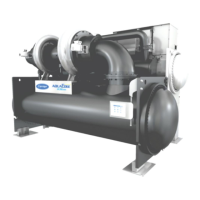70
Fig 40 – 19DV leak test procedure
5.1.6.2 Refrigerant Tracer
Carrier recommends the use of an environmentally acceptable refrigerant tracer for leak testing with an electronic
detector. Ultrasonic leak detectors can also be used if the chiller is under pressure.
WARNING: Do not use air or oxygen as a means of pressurizing the chiller. Mixtures of HFO R-1233zd(E) and air
at elevated pressure can undergo combustion, resulting in equipment damage and possible personal injury.
5.1.6.3 Leak Test Chiller
Due to regulations regarding refrigerant emissions and the difficulties associated with separating contaminants
from the refrigerant, Carrier recommends the following leak test procedure. Refer to Table XX for refrigerant
pressure/temperature values.
1. If the pressure readings are normal for the chiller condition:
a. Evacuate the charge from the vessels, if present.
b. Raise the chiller pressure, if necessary, by adding refrigerant until pressure is at the equivalent saturated
pressure for the surrounding temperature.
CAUTION: Never charge liquid refrigerant into the chiller if the pressure in the chiller is less than R-1233zd(E)
saturation pressure corresponding to local temperature. Charge as a gas only, with the cooler and condenser pumps
running, until this pressure is reached, using PUMPDOWN/LOCKOUT (located in the Maintenance menu) and
END LOCKOUT mode on the PIC5+ control interface. Flashing of liquid refrigerant at low pressures can cause
tube freeze-up and considerable damage.

